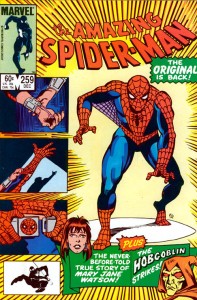 Origin stories have long been the bread and butter of superhero comics. Traditionally, a character’s origins are explained in the issue where he makes his first appearance (Spider-Man/Peter Parker’s in Amazing Fantasy #15, Doctor Octopus in Amazing Spider-Man #3, Sandman in ASM #4). Certain “special” characters make their first appearances shrouded in mystery, with an origin story revealed at later date (Green Goblin first appears in ASM #14, origin told in ASM #40).
Origin stories have long been the bread and butter of superhero comics. Traditionally, a character’s origins are explained in the issue where he makes his first appearance (Spider-Man/Peter Parker’s in Amazing Fantasy #15, Doctor Octopus in Amazing Spider-Man #3, Sandman in ASM #4). Certain “special” characters make their first appearances shrouded in mystery, with an origin story revealed at later date (Green Goblin first appears in ASM #14, origin told in ASM #40).
But Mary Jane Watson is not a superhero, and while her first appearance was teased in a number of Stan Lee/Steve Ditko issues leading up to her famous“Face it Tiger” moment in ASM #42, once she arrived, she wasn’t exactly shrouded in mystery. And yet it took 18 years and more than 200 issues of Amazing Spider-Man comics for somebody (Tom DeFalco) to finally attempt to explain why this bouncy, flighty, sometimes-swinger was the way she was.
The gap between ASM #42 and ASM #259 is so wide in terms of real-time and comic book continuity time, it almost feels like DeFalco scripted a retcon. But ASM #259 is not the comic book equivalent of an airbrushing. The logic behind unveiling MJ’s origins is sound: shortly after she rejects Peter’s (first) marriage proposal in ASM #182, Mary Jane disappears from New York City and the comic book world, giving Peter the freedom to operate romantically unencumbered (as well as date Black Cat/Felicia Hardy). She returns in the mid-1980s as a much more serious character and rekindles her friendship with Peter. However, after Peter once again disappears to play the role of Spider-Man, she calls him out on his secret. In ASM #259 she tells Peter that now that she knows his darkest secret, it’s time for him to know hers.
Sure, there are some clichéd elements to Mary Jane’s back story – why does every interesting comic book character have to come from a broken family of some sort? Is it a universally accepted fact that a character with depth and nuance has to have his lens of the world colored by divorce, abuse or alcoholism? But at the same time, what DeFalco outlines in ASM #259 explains SO much about Mary Jane, that it’s hard for me to pick nits with it years later.
What I find most interesting about this story is how DeFalco deploys a two-pronged approach in explaining MJ’s commitment phobia. First there’s her father, who aspires to be a writer, but instead becomes an abusive jerk who resents his wife for tying him down with children. And then there’s MJ’s sister, an aspiring dancer who marries her high school sweetheart right after graduation, pops out a kid, and then finds herself jilted and alone when her husband walks out on her after learning they’re expecting a second child.
Adding another layer to MJ’s characterization is the fact that she also abandons her sister after her mother dies and she faces the prospects of having to stay back and help her sister raise her two children. That’s actually a shocking admission from Mary Jane and of all the secrets she reveals, her desertion of her surviving family is far more deplorable than the fact that her father was cold and cruel to her.
What makes MJ’s origin so fascinating is how it mirrors elements of Peter’s origin (this idea is also explored in the original graphic novel “Parallel Lives”). After her mother left her father, Mary Jane explains that she buried her emotions by being a class clown, often performing in plays (including a great scene where she drops “Tiger” in a production of Romeo and Juliet) to try and draw positive attention to herself. The entire concept of free-swinging, fun-loving Mary Jane is actually a mask she wears as a coping mechanism for the guilt she feels about her broken family and the ways she created many of these irreparable fractures. Just as Peter took on the masked identity of Spider-Man to try and make up for the sins he committed that led to the murder of his Uncle Ben in Amazing Fantasy #15.
Even the presentation of MJ’s origin story mirrors Peter’s in Amazing Fantasy #15. In a clever nod to Ditko’s dense-plotting style, Ron Frenz’s pencils provide a vintage Silver Age aesthetic when MJ tells her tale. Frenz packs nine panels on each of these pages and doesn’t waste any space.
While books like Sean Howe’s Marvel Comics: The Untold Story, make it sound like Peter and Mary Jane’s marriage was an inevitability – legends goes that then-Marvel editor-in-chief Jim Shooter was obsessed with creating “big events” and generating mainstream media buzz and the wedding of one of his most popular characters was a surefire way to scratch those itches – DeFalco’s origin story goes a long way in establishing that perhaps Mary Jane has been Peter’s soul mate all along.
For years, the accepted truth in the comic book world was that Peter and Gwen were star-crossed lovers. And while stories like the wonderful Spider-Man: Blue showcase just how beautiful the Peter/Gwen dynamic was in its hey-day, I’ve also been on record in saying a lot of the magic between those two disappeared after the death of Gwen’s father in ASM #90. Many of the Peter/Gwen stories leading up to Gwen’s death were downright terrible and came dangerously close to tarnishing the character’s reputation. Gwen’s death, in many ways, saved her from becoming just another nagging, weeping superhero girlfriend. The Bronze Age MJ wasn’t that much better in terms of characterization – she was basically a savvier, more sarcastic-version of Gwen – but ASM #259 marks the start of something special, even if the whole thing was planned for cynical, cash-grabbing reasons.
I’ve long maintained that Gerry Conway’s epilogue in ASM #122 was a true turning point for MJ the character, and that the compassion she showed Peter in the wake of Gwen’s death went a long way in planting the seeds for an eventual “real” romance between the two. But as MJ herself says in ASM #259, the two still don’t really know each other. DeFalco’s origin story goes a long way in fixing that, and makes all of the stories about the pairing that followed ring truer than any other of Peter’s prior romantic relationships. In retrospect, it might seem absurd that it took so long for Marvel to finally give MJ a story, but in the case of ASM #259, it was well worth the wait.
All images from Amazing Spider-Man #259: Tom DeFalco, Ron Frenz & Josef Rubinstein. Cover by Ron Frenz.

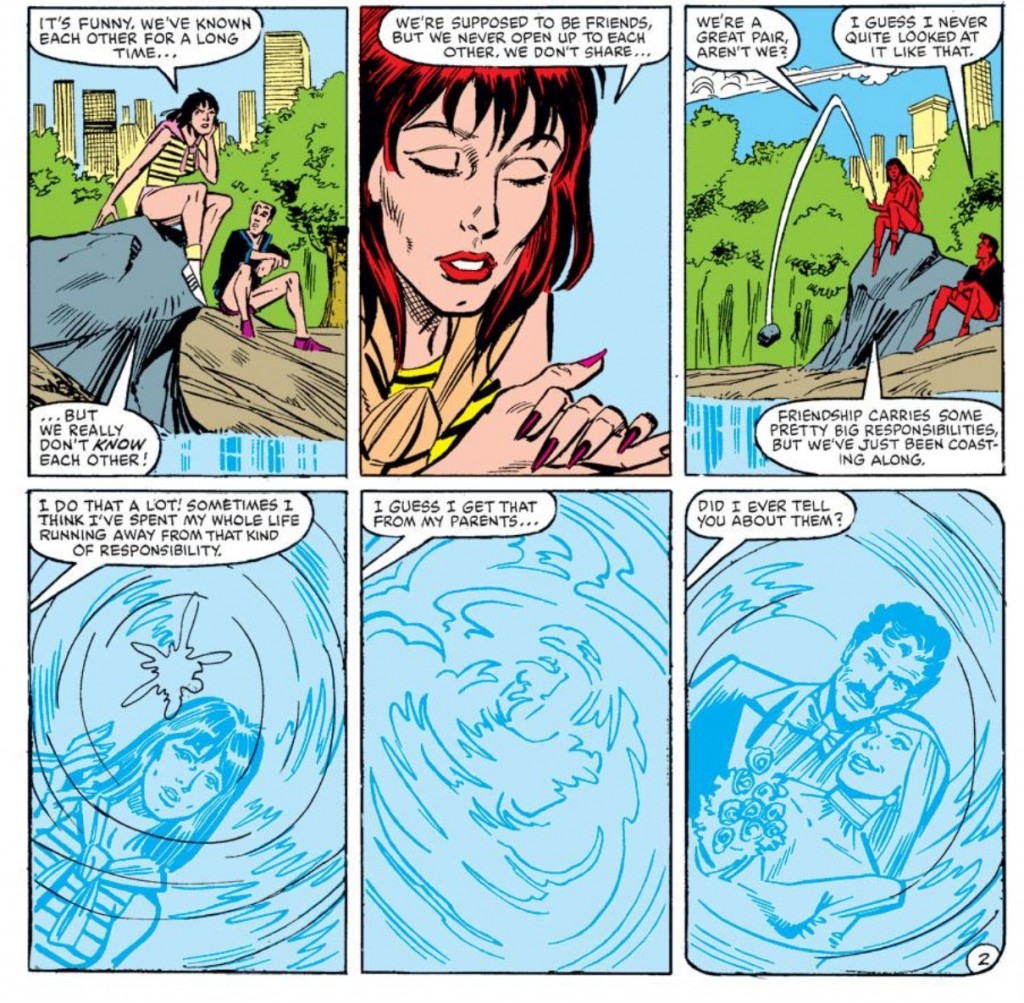
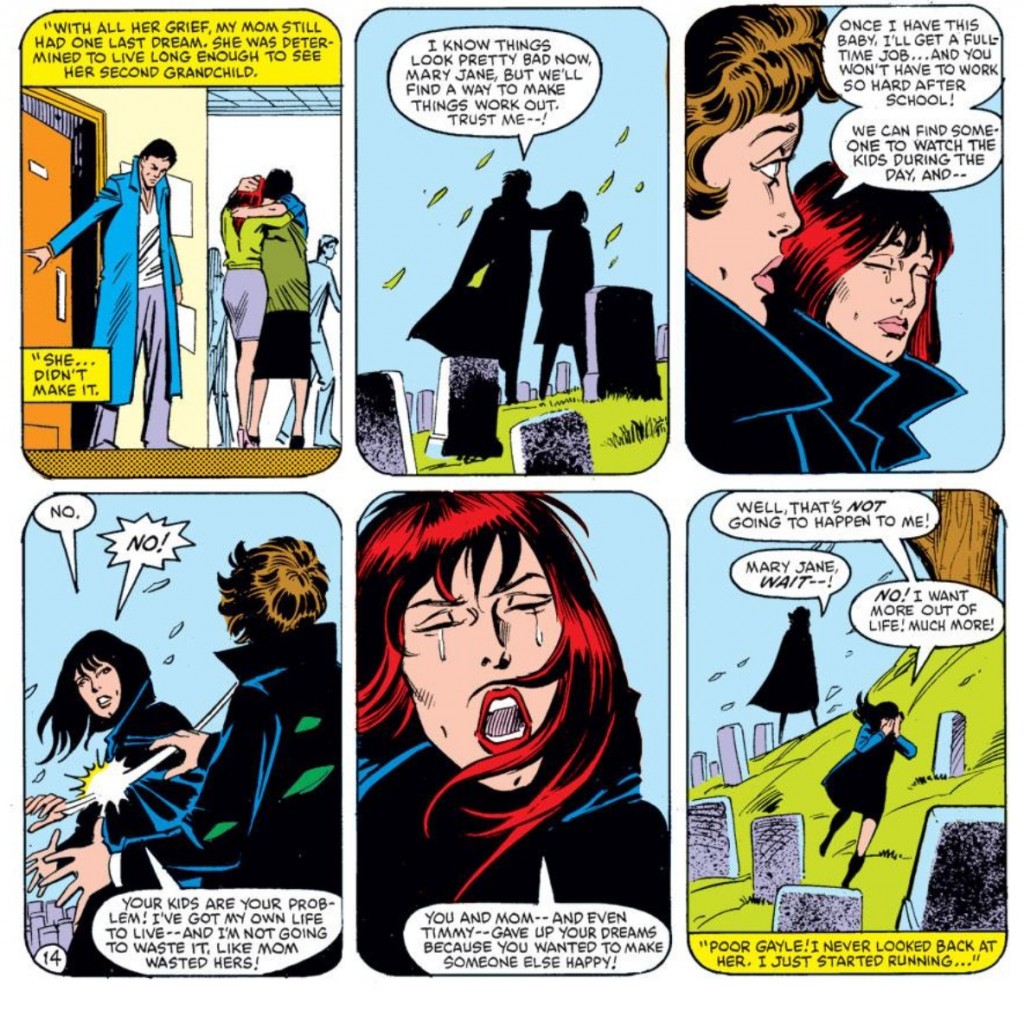
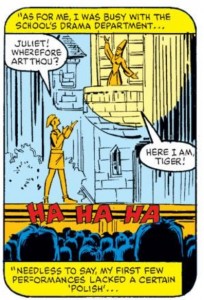
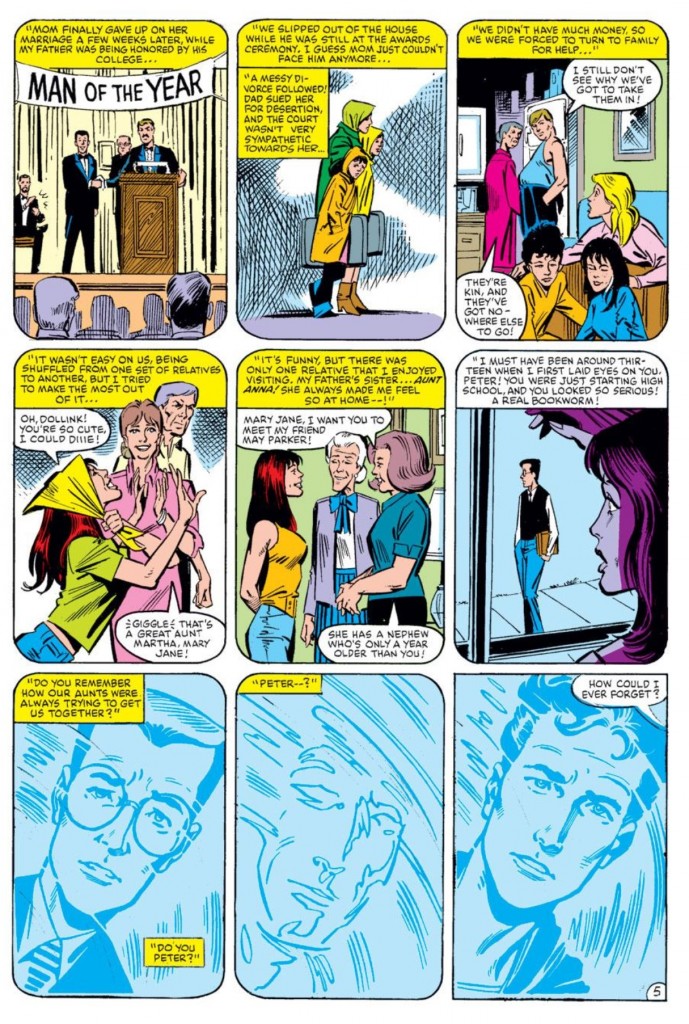
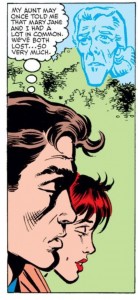

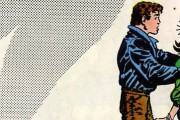


Very nice post, Mark. The last time I read this issue was too long ago for me to have picked up on the Silver Age aesthetic Frenz brings to bear on the story, so that was a really interesting (and memory-jogging) point! This is one of the few retcons I can think of that doesn’t come with any major negatives, and the only one of that kind I can think of that involves a romance between two characters. (The only one in comics, at least — if we’re talking narrative art in general, Cory and Topanga might take the cake.)
I’ve never read Parallel Lives; do you think it undermines this issue by giving MJ a long-time knowledge of Peter’s secret identity, or does it really just cement the “soul mate” angle?
Marc, I read “Parallel Lives” a while go so it’s not freshest in my memory, but ultimately the whole thing felt rather inconsequential and I don’t think it sullies past events in any meaningful way. Plus it’s Gerry Conway, and he’s always alright by me with a few exceptions.
Fantastic story and art. And great article!
Peter Parker and Mary Jane’s relationship is, for me, the best in comics. Small things happened through the decades and their intimacy with each other has been built up in a beautiful way.